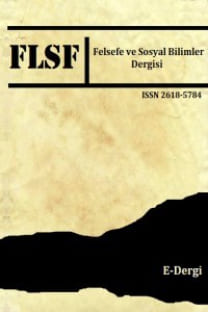Şamanik Şeflerden Gastronomik Şeflere Varlığın Mideye İndirilmesi
FROM SHAMAN CHIEFS TO GASTRONOMIC CHEFS INGESTING THE BEING
___
Referans1 Aria, M. – Bellanca, N. (2012). “The Four Figures of Gift: Kula, Potlach, Dan and Hau”, Dipartimento di Science Economiche Universita degli Studi di Firenze Working Paper Series, No: 21.Referans2 Arppe, T. (2009). “Sorcerer’s Apprencites and the ‘Will to Figuration’: The Ambiguous Heritage of the Collège de Sociologie”, Theory, Culture & Society, 26: 117. Aydın, M.S. (2009). Sanat İçin Yemek, Yemek İçin Sanat, Hacettepe Üniversitesi Sanatta Yeterlik Tezi, Ankara.
Referans3 Bataille, (1995). Encyclopedia Acephalica, Atlas Press, London.
Referans4 Bataille, G. (1988). The Accursed Share: An Essay on General Economy, çev. Robert Hurley, New York: Zone Books.
Referans5 Beşirli, H. (2010). “Yemek, Kültür ve Kimk”, Milli Folklor, Sayı 87.
Referans6 Boghini, A. (2016). “Hunger”, Encyclopedia of Food and Agricultural Ethics, Springer Science + Business Media B.V. Referans7 Corr, R. (2002). “Reciprocity, Communion, and Sacrifice: Food in Andean Ritual and Social Life”, Food & Foodways, 10.
Referans8 Dietler, M. (2011). “Feasting and Fasting”, ed. by Timothy Insoll, The Oxford Handbook of the Archeology of Ritual and Religion.
Referans9 Direk, Z. (2020). “Bataille: Tarih, Egemenlik ve Çöp”, (online), 20.09.2020 https://noktahaberyorum.com/bataille-tarih-egemenlik-ve-cop-zeynep-direk.html#.X2YklWgzZPY
Referans10 Douglas, M. (1972). “Deciphering a Meal”, Daedalus Journal of the American Academy of Arts and Sciences. Winter: Myth, Symbol, and Culture Issued as Vol. 101, No. 1, of the Proceedings of the American Academy of Arts and Sciences.
Referans11 Douglas, M. (2007). Saflık ve Tehlike, çev. Emine Ayhan, İstanbul, Metis.
Referans12 Durkheim, (1951). Suicide, trans. John A. Spaulding – George Simpson, Routledge.
Referans13 Eker, G.Ö. (2018). “Farklı Görme Biçimiyle Modern Dünya Ritüeli Olarak Yemek Kültürü: Sınanma/Erginlenme ve İntikam Alma Gizli İşlevleri”, Milli Folklor 120.
Referans14 Geçer, H. – Topçu, S. (2017). “Arkaik Bir Törenin Postmodern İzdüşümleri: Potlaç Geleneğinden Tüketim Kültürüne”, Uluslararası Sosyal Araştırmalar Dergisi, cilt 10, sayı 52.
Referans15 Halligan, M. (1990). Eat My Words. Sdney: Angus & Robertson.
Referans16 Kitapcı, İ. (2019). “Gösterişçi Tüketim Örneği Olarak Potlaç Kültürü ve Günümüzün Küresel Kapitalist Dünyasındaki Yansımaları”, Mehmet Akif Ersoy Üniversitesi Sosyal Bilimler Enstitüsü Dergisi, cilt 11, sayı 29.
Referans17 Ladenis, (1997). My Gastronomy, rev edn., Macmillan, London.
Referans18 Leone, M. (2016). Critique of the Culinary Reason, University of Turin.
Referans19 Mauss, M. (1972). A General Theory of Magic, trans. Robert Brain, Routledge.
Referans20 Mauss, M. (2018). Armağan Üzerine Deneme, Arkaik Toplumlarda Değiş Tokuşun Biçimi ve Nedeni, Alfa Yayınları, 1. Basım, İstanbul.
Referans21 Meigs, A. (1997). “Food as Cultural Construction.” Food and Culture: A Reader, edited by Carole Counihan and Penny Van Esterik. New York: Routledge.
Referans22 Palmer – Cooper - Burns, (2010). “Culture, identity, and belonging in the ‘culinary underbelly’”. International Journal of Culture, Tourism and Hospitality Research, 4 (2).
Referans23 Papilloud, C. (2004). “Three Conditions of Human Relations: Marcel Mauss and Georg Simmel”, Philosophy & Social Criticism, 30. Referans24 Tischer, J. (2016). “Gifted Society – An Essay on the Gift”, ProSeminar Etnography and the History of Social Theory in Anthropology.
Referans25 Tomasi, D.L. (2018). “From the Heart to the Mind, Through the Stomach”, A Review of Donald Phillip Verene’s The Science of Cookery and the Art of Eating Well: Philosophical and Historical Reflections on Food and Dining in Culture, ibidem Press.
Referans26 Tuğrul, S. (2010). Ebedi Kutsal Ezeli Kurban Çok Tanrılılıktan Tek Tanrılılığa Kutsal ve Kurbanlık Mekanizmaları, İletişim, İstanbul. Referans27 When Bataille Attacked the Metaphysical Principle of Economy, (2013). Trans. Stuart Kendall, Scapegoat.
Referans28 Yankova, M. (2014). “Darat Mejdu Filosofiata i Religiata”, Nauchni Trudove na Rusenskia Universitet, 2014, tom 53, seria 6.2.
- Yayın Aralığı: Yılda 2 Sayı
- Başlangıç: 2006
- Yayıncı: Hamdi BRAVO
KARL MARX'IN SINIF MÜCADELESİ VE POLİTİK EKONOMİ ANLAYIŞININ ARISTOTELESÇİ TEMELLERİ
ALTIN BİR ELMA? ÇAĞDAŞ ARAPÇA VE TÜRKÇE ARAŞTIRMALARDA LEO STRAUSS'UN ALGISI ÜZERİNE
Rousseaucu Logosantrizm ve Lakonofili: Sparta Bir Mitik Ütopya Mıdır Politik Ütopya Mı?
Heidegger'de 'Herkes' Sorunsalı
Karl Marx'ın Sınıf Mücadelesi ve Politik Ekonomi Anlayışının Aristotelesçi Temelleri
HUSSERL'İN BAŞKASININ BENİNİN ARISTOTELES'İN DOST KAVRAMI ÜZERİNDEN YENİDEN DÜŞÜNÜLMESİ
Husserl'in Başkasının Beninin Aristoteles'in Dost Kavramı Üzerinden Yeniden Düşünülmesi
LOUIS ALTHUSSER'DE MAKİNE VE AYGIT AYRIMI BAĞLAMINDA DEVLET NOSYONU
